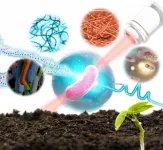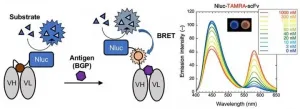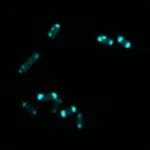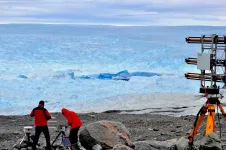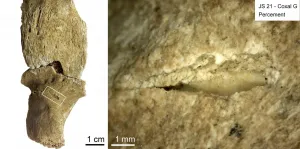INFORMATION:
Researchers develop technique to functionally identify and sequence soil bacteria one cell at a time
2021-05-27
(Press-News.org) Researchers from the Single-Cell Center at the Qingdao Institute of Bioenergy and Bioprocess Technology (QIBEBT) of the Chinese Academy of Sciences have developed a technique to sort and sequence the genome of bacteria in soil one bacterial cell at a time, while also identifying what its function is in the soil environment.
Their study was published in the journal mSystems on May 27.
Soil is home to a vast and complex microbiome, which features arguably the highest genomic diversity and widest heterogeneity of metabolic activities of cells on Earth. In turn, these metabolic activities can in principle provide the foundation for industrial production of numerous compounds of value.
The ability to pinpoint "who is doing what" in the soil microbiome has until now been extremely difficult at the resolution of a single cell, as normally a great many cells, typically millions of them, have had to be analyzed at the same time.
In 2020, researchers from the QIBEBT Single-Cell Center developed a bacteria-profiling technique called Raman-Activated Gravity-driven single-cell Encapsulation and Sequencing, or RAGE sequencing. This sequencing technique uses laser "tweezers" and takes advantage of the properties of gravity to permit analysis of bacteria cells one by one. The form and structure of a bacterium are then investigated using 'Raman spectroscopy', a method of analysis that uses how light interacts with the chemical bonds in a molecule to enable identification.
They have now developed their RAGE sequencing technique into a new scientific instrument they are calling a Raman-activated Cell Sorter-Sequencer or RACS-Seq. It is the first instrument in the world that can pinpoint "who is doing what" at precisely one-cell resolution in complex ecosystem. And they applied it to the bacteria in soil.
The Raman spectra of a single cell offers an intrinsic biochemical fingerprint, and this in turn can be used as a proxy of its metabolic activity. When this single-cell Raman spectra (SCRS) is coupled with probing of the isotopes involved in this activity, the technique can reveal the amount of chemical from the cell's environment that it is taking up.
Isotopes are often used as a way to track or trace chemical processes. Deuterium, for example, is an isotope of hydrogen with one neutron (regular hydrogen has zero neutrons), and is found in heavy water (water molecules where the regular hydrogen is replaced by deuterium: D2O instead of H2O).
By feeding the bacteria with heavy water, the general metabolic activity of the cells can be tracked via Raman spectra. The technique can also detect not only uptake of D2O but also different isotopes of carbon or nitrogen. This can even reveal the particular cellular profile of synthesis of biological molecules.
This metabolic tracking can then be linked via the RAGE technique to individual cells whose genome can be sequenced.
"This should allow researchers to 'mine' soil to find bacteria of interest that are in the business of producing particular carotenoids, lipids, polysaccharides, protein and even antibiotics," said JING Xiaoyan, a microbiome scientist with the QIBEBT Single-Cell Center and the article's lead author.
The researchers now want to further improve the throughput of their technique, at a few cells per minute currently, to speed up and fully automate the process.
"Our goal ultimately is to keep optimizing the RACS-Seq instrument, so that it becomes a universal and highly versatile tool for precisely probing target cells or metabolic activities of interest," added XU Jian, the article's corresponding author and Director of the QIBEBT Single-Cell Center. "And not just from soil, but from any other complex natural ecosystem."
ELSE PRESS RELEASES FROM THIS DATE:
Shedding new light: A new type of immunosensor for immunoassay tests
2021-05-27
Immunosensors are widely used in immunoassays to detect antigens. One such immunosensor is a quenchbody (Q-body), which contains a modified antibody fragment with a quenched fluorescent dye. When an antigen binds to the Q-body, the dye leaves the antibody and the fluorescence intensifies. The change in fluorescence intensity is easy to measure, making Q-body-based antigen detection systems incredibly simple. However, this method requires an external light source to excite the electrons in the fluorescent dye to produce luminescence.
One way to solve this is to induce luminescence by an alternative method. To achieve this, researchers ...
Climate skeptics not easily persuaded by available evidence, now or later
2021-05-27
EUGENE, ORE. -- May 27, 2021 -- Climate skeptics who aren't persuaded by the existing evidence from climate change are unlikely to change their minds for many years, according to a newly published quantitative study by a University of Oregon environmental economist
The central question posed by the study published in the journal Climate Change was "How much evidence would it take to convince skeptics that they are wrong?" The answer depended on the degree of skepticism. The study modeled two types of hypothetical skeptics -- those who were less extreme and believed the change in temperature was slight, as well as ...
Not fear, but goal importance and others' behavior makes you favour COVID-19 measures
2021-05-27
While earlier research has mostly looked into factors such as fear, perceived risk, age and political views to determine what makes individuals and societies more or less willing to drastically change their lifestyle and support government-imposed strict restrictions, in order to mitigate the spread of the COVID-19 pandemic, psychologists at the University of Zurich Charlotte Kukowski, Katharina Bernecker and Veronika Brandstätter took a different perspective.
Instead, they chose to find out the impact of people's perception of others' behaviour when it comes to the public good, as well as people's own self-control in sticking to behaviour guidelines. By using data from the United Kingdom and Switzerland, they concluded that, ...
Fight against antibiotic-resistant bacteria has a glowing new weapon
2021-05-27
AUSTIN, Texas -- In the perpetual arms races between bacteria and human-made antibiotics, there is a new tool to give human medicine the edge, in part by revealing bacterial weaknesses and potentially by leading to more targeted or new treatments for bacterial infections.
A research team led by scientists at The University of Texas at Austin has developed chemical probes to help identify an enzyme, produced by some types of E. coli and pneumococcal bacteria, known to break down several common types of antibiotics, making these bacteria dangerously resistant to treatment.
"In response to antibiotic ...
The robot smiled back
2021-05-27
New York, NY--May 27, 2021--While our facial expressions play a huge role in building trust, most robots still sport the blank and static visage of a professional poker player. With the increasing use of robots in locations where robots and humans need to work closely together, from nursing homes to warehouses and factories, the need for a more responsive, facially realistic robot is growing more urgent.
Long interested in the interactions between robots and humans, researchers in the Creative Machines Lab at Columbia Engineering have been working for five years to create EVA, a new autonomous robot with a soft and expressive ...
Archaeology: Prehistoric violence at Jebel Sahaba may not have been single event
2021-05-27
Reanalysis of the prehistoric cemetery Jebel Sahaba (Sudan), one of the earliest sites showing human warfare (13,400 years ago), suggests that hunter-fisher-gatherers engaged in repeated, smaller conflicts. The findings are published in Scientific Reports. Healed trauma on the skeletons found in the cemetery indicates that individuals fought and survived several violent assaults, rather than fighting in one fatal event as previously thought.
Isabelle Crevecoeur and colleagues reanalysed the skeletal remains of 61 individuals, who were originally ...
Icebergs push back
2021-05-27
Shortly before Jakobshavn Isbræ, a tidewater glacier in Greenland, calves massive chunks of ice into the ocean, there's a sudden change in the slushy collection of icebergs floating along the glacier's terminus, according to a new paper led by the Cooperative Institute for Research in Environmental Sciences (CIRES) at CU Boulder. The work, published in Nature Geoscience, shows that a relaxation in the thick aggregate of icebergs floating at the glacier-ocean boundary occurs up to an hour before calving events. This finding may help scientists better understand future sea-level rise scenarios and could also help ...
Jebel Sahaba: A succession of violence rather than a prehistoric war
2021-05-27
Since its discovery in the 1960s, the Jebel Sahaba cemetery (Nile Valley, Sudan), 13 millennia old, was considered to be one of the oldest testimonies to prehistoric warfare. However, scientists from the CNRS and the University of Toulouse - Jean Jaurès (1) have re-analysed the bones preserved in the British Museum (London) and re-evaluated their archaeological context. The results, published in Scientific Reports on May 27, 2021, show that it was not a single armed conflict but rather a succession of violent episodes, probably exacerbated by climate change.
Many individuals buried at Jebel Sahaba bear injuries, half ot them caused by projectiles, the points of which were found in the bones or the fill where the body was located. The ...
Association of tracheostomy with outcomes in patients with COVID-19 and SARS-CoV-2 transmission among health care workers
2021-05-27
What The Study Did: The findings of this systematic review and meta-analysis indicate that enhanced personal protective equipment is associated with low rates of SARS-CoV-2 transmission during tracheostomy.
Authors: Phillip Staibano, M.Sc., M.D., of McMaster University in Ontario, Canada, is the corresponding author.
To access the embargoed study: Visit our For The Media website at this link https://media.jamanetwork.com/
(doi:10.1001/jamaoto.2021.0930)
Editor's Note: The article includes conflict of interest disclosures. Please see the article for additional information, including other authors, author contributions and affiliations, conflict of interest and financial ...
Factors associated with racial/ethnic group-based medical mistrust, perspectives on COVID-19 vaccine
2021-05-27
What The Study Did: This survey study of adults living Michigan during the COVID-19 pandemic examines associations between race/ethnicity, medical mistrust within racial/ethnic groups and willingness to participate in COVID-19 vaccine trials or to receive a COVID-19 vaccine.
Authors: Hayley S. Thompson, Ph.D., of the Wayne State University School of Medicine in Detroit, is the corresponding author.
To access the embargoed study: Visit our For The Media website at this link https://media.jamanetwork.com/
(doi:10.1001/jamanetworkopen.2021.11629)
Editor's Note: The article includes conflict of interest and funding/support disclosures. Please see the article for additional information, including other authors, author contributions and affiliations, ...
